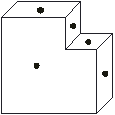How many faces?
This task is about identifying the number of faces on 3-dimensional shapes.
In the example, there is a dot on each of the 5 faces that you can see, but there are 3 faces on the back and underneath you cannot see.
So, the shape in the example has eight faces (5 + 3) in total.
So, the shape in the example has eight faces (5 + 3) in total.
Example:

Number of faces: ___8___

